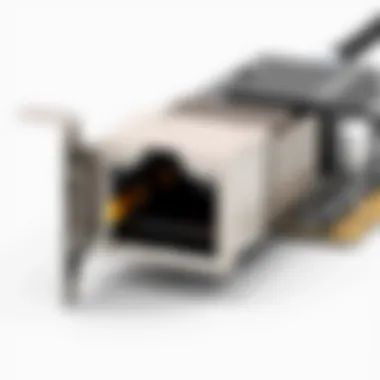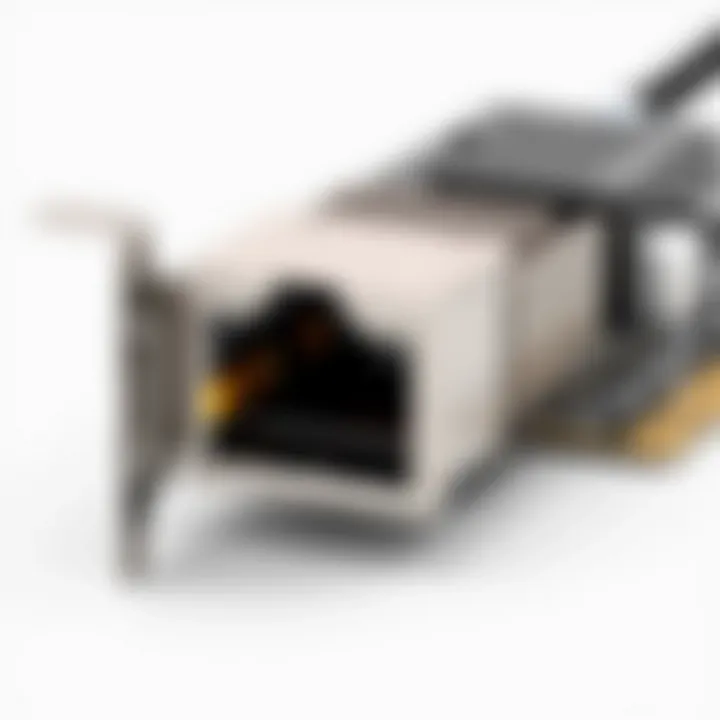In-Depth Review of 10-Gig Ethernet Cards for Modern Networking


Intro
In today's fast-paced digital world, networking demands are evolving at a blistering pace. Among the various components that facilitate seamless connectivity, 10-gig Ethernet cards stand out as a critical player in this landscape. These powerful devices are designed to handle vast amounts of data, making them indispensable for businesses, gamers, and tech enthusiasts alike.
As bandwidth requirements soar, understanding the intricacies of 10-gig Ethernet cards becomes crucial not just for professionals but also for any individual aiming to enhance their networking experience. Whether you're looking to upgrade your home setup or implement solutions for a large-scale enterprise, navigating the selection process for these cards can be quite daunting. This article aims to clarify some of that confusion by offering a detailed analysis of essential features, performance metrics, and practical installation tips.
We’ll delve deep into how these cards function, their significance in modern networks, and provide insights into what to consider when acquiring one. By the end of this exploration, readers will have a richer understanding of 10-gig Ethernet cards, paving the way for informed decisions that meet personal or business needs.
Let’s jump right into the product overview to get a clearer picture of what these technological marvels entail.
Product Overview
Key Features
10-gig Ethernet cards are equipped with a variety of features designed to optimize network performance:
- Increased Bandwidth: Capable of transferring data at 10 Gbps, supporting heavy loads with ease.
- Low Latency: Accelerated data transmission ensures minimal delays, essential for applications like online gaming or live streaming.
- Enhanced Reliability: Many models provide error checking and correction protocols, improving overall data integrity.
Technical Specifications
When considering 10-gig Ethernet cards, it’s essential to look into their specifications:
- Form Factor: Available in PCIe, SFP+, and others depending on the installation environment.
- Connector Type: RJ45 and fiber optics are commonly used, each suited for different setups.
- Compatibility: Check whether the card matches your system requirements including operating systems and bandwidth needs.
Pricing Information
The cost of 10-gig Ethernet cards can vary widely, influenced by specifications and manufacturers. On average, prices can range from $100 to $500, depending on the brand and features offered. Higher-end models with advanced capabilities may command even steeper prices, but understanding the right balance between cost and performance is key.
Performance Analysis
Benchmark Results
When it comes to performance, benchmark testing reveals how well 10-gig Ethernet cards handle traffic:
“10-gig Ethernet cards demonstrate clear advantages in scenarios demanding high data rates, outperforming their 1-gig counterparts significantly.”
Several tests illustrate that under consistent load, these devices maintain superior throughput, showing results that exceed expectations.
Real-World Use Cases
10-gig Ethernet cards play a vital role in several environments:
- Data Centers: Support high-capacity connections, ensuring swift data handling and processing.
- Gaming: Provide stable connections critical for multiplayer experiences, reducing lag which can be a game changer.
- Content Creation: Ideal for streaming and video editing where large files are the norm.
Comparison with Competitors
A comparison between leading brands can offer insights on performance. For example, cards from Intel and ASUS typically showcase superior reliability and customer support, making them popular choices among consumers. Meanwhile, other brands might offer competitive pricing that appeals to budget-conscious buyers.
Installation and Setup
Required Tools and Components
Before installation begins, gather the following:
- Screwdriver for securing the card in place.
- Compatible SFP+ modules if using fiber optics.
- Appropriate drivers, which can usually be downloaded from the manufacturer's site.
Step-by-Step Installation Guide
The installation process for a 10-gig Ethernet card generally follows these lines:
- Power Down Your System: Ensure everything is turned off before opening your computer.
- Open the Case: Use the screwdriver to remove screws holding the side panel.
- Locate the PCIe Slot: Identify an empty slot on the motherboard.
- Insert the Card: Align and firmly push the card into the slot until it’s seated properly.
- Secure the Card: Use screws to fix the card in place.
- Power Up and Install Drivers: Restart your system and install drivers as needed.
Troubleshooting Common Issues
If issues arise during installation or usage, here are common fixes:
- Check physical connections: ensure wires are plugged in snugly.
- Update drivers: sometimes, outdated software leads to performance problems.
- Use different ports: switching the card to another PCIe slot may resolve conflicts.
Pros and Cons
Advantages of the Product
10-gig Ethernet cards provide numerous benefits:
- Superior speed and performance compared to older models.
- Future-proof technology as more applications require higher bandwidth.
Disadvantages or Limitations
However, there are a few downsides worth noting:
- Cost can be prohibitive for some users.
- Compatibility issues: Not all systems support 10-gig connections out-of-the-box.
Who It’s Best Suited For


These cards cater best to:
- Businesses requiring enhanced network reliability.
- Gamers and streamers needing optimal performance.
Final Thoughts
Summary of Key Points
To recap, our journey through the world of 10-gig Ethernet cards highlighted their pivotal role in bolstering network performance. We've seen their multifaceted features, applications in real-world settings, as well as the installation process.
Recommendations for Potential Buyers
For anyone in the market, consider your specific needs before making a choice. Look for cards that offer the best combination of features at a price that suits your budget.
Future of the Technology or Product Line
As the demand for faster data transfer continues to escalate, the future of 10-gig Ethernet cards seems promising. It’s not just about speed; it’s about the evolving technological landscape that will undoubtedly shape the next generations of networking equipment.
For more information on networking technologies, consider visiting Wikipedia, Britannica, or engage with communities on platforms like Reddit for advice from experienced users.
Preamble to 10-Gig Ethernet Cards
In a world where the digital landscape is evolving at a breakneck pace, the need for efficient and high-speed network connectivity is more pressing than ever. Enter 10-Gig Ethernet cards—the superhero of modern networks. Their importance cannot be overstated, as they offer the high data transfer rates required to keep our increasingly interconnected devices running smoothly.
These networking components are not just about speed; they're about enabling a seamless experience in various applications, from gaming and streaming to crucial business operations. With the relentless rise in bandwidth requirements driven by cloud computing, video conferencing, and big data analytics, having a robust solution is imperative.
The 10-Gig Ethernet card serves as a vital connection point in this tech tapestry, helping organizations to reduce latency, improve network reliability, and support multiple users and devices without a hitch. It’s like upgrading from a bicycle to a rocket—once you experience that leap in performance, there’s no going back.
Moreover, the choice of the right Ethernet card can influence the performance of an entire network. This introduction sets the stage for a deeper dive into the intricacies that make these networking cards an essential part of today's technology stack. The following sections will outline profound aspects such as increases in bandwidth demands, the broad spectrum of applications across sectors, and critical technical specifications. These insights will equip readers with the knowledge they need to make informed choices about their networking infrastructure.
"Understanding the capabilities of 10-Gig Ethernet cards is crucial for both novice users and seasoned professionals alike, as we navigate an era where speed and efficiency are king."
In a nutshell, 10-Gig Ethernet cards do more than gather dust in a motherboard—they’re the backbone of an efficient digital experience, bridging the gap between performance needs and technological advancements. As we move further into this discussion, it’ll become clear why investing in a 10-Gig Ethernet card is more than just a smart choice; it's a necessity for anyone serious about harnessing the full potential of their network.
Understanding Ethernet Technology
In the realm of networking, understanding Ethernet technology is akin to understanding the very fabric of connectivity. As data demands skyrocket, the relevance of Ethernet becomes ever more pronounced. Ethernet isn't just an old technology; it’s the robust framework that supports the Internet, local networks, and everything in between. Grasping its principles is essential for leveraging the full potential of 10-gig Ethernet cards.
The Evolution of Ethernet
Ethernet has come a long way since its early days. Originally conceived in the 1970s, this technology has seen a vast transformation. Back then, it supported a meager 2.94 Mbps. Fast forward to the present, and we’re gliding past gigabits; 100 Gbps is not just a dream but a reality in higher-end networking solutions.
The evolution can be categorized into distinct generations:
- Classic Ethernet: The one that started it all; connections via coaxial cables what may seem antiquated today.
- Fast Ethernet: This jumped onto the scene when the world demanded quicker speeds, introducing 100 Mbps.
- Gigabit Ethernet: It’s almost a household name now, offering an impressive 1 Gbps.
- 10-Gig Ethernet: This is the current gold standard, catering to high-performance environments, ensuring data flows smoothly without hiccups.
Ethernet's adaptability to change and scaling is a testament to its design. Notably, while newer standards incorporate advanced features, they still maintain backward compatibility, making transitions easier for businesses of all sizes.
Basics of Data Transmission
Understanding how data transmission works in Ethernet systems is crucial. It boils down to the framing of data packets, guiding them through various network nodes till they reach their destination. Here's a simple breakdown:
- Framing: Data is encapsulated within frames that carry not just the payload but also essential control information. Each frame can be compared to an envelope containing both the message and the address.
- Sending and Receiving Nodes: Data is transmitted between devices connected to the same network through specific connectors and cables. Every device listens for incoming frames and determines whether those frames are meant for them.
- Collision Detection: In older Ethernet models, collisions were a nightmare. The technology had to develop ways to detect when two devices sent data simultaneously. Modern version, like 10-gig, practically eradicates this problem by providing dedicated channels, akin to having unique lanes on a highway.
- Protocol Standards: The IEEE governs Ethernet standards, ensuring consistency and interoperability. Devices that claim to be Ethernet-compatible adhere to these standards, reducing the risk of communication failure between disparate systems.
Ethernet remains the backbone of most corporate networks, maintaining a lead over other technologies by its simplicity and reliability.
The understanding of these elements not only enhances one’s knowledge about Ethernet cards but is also foundational for grasping how they improve network performance. Knowing that these cards provide various capabilities to manage data effectively can make all the difference when selecting the right technology for a specific need.
As we move further into the specifics of 10-gig Ethernet cards, having this background will prove invaluable. For a more detailed understanding, consider these resources:
In essence, as companies demand more reliable networks to handle increasing data loads, knowing the intricacies of Ethernet technology makes one well-prepared to adapt and thrive.
Significance of 10-Gig Ethernet Cards
The advent of 10-gig Ethernet cards has sparked a necessary evolution in various spheres of technology and communication. As businesses and individuals grapple with skyrocketing data demands, the role of these cards in enhancing connectivity cannot be overstated. They are not merely upgrades from previous technology; they represent a new standard for high-performance networking that caters to a multitude of needs. By facilitating faster data transfers and enabling superior network efficiency, these cards play a critical role in shaping modern network infrastructure.
Increasing Bandwidth Needs
The growing appetite for bandwidth in our digital-centric world is undeniable. Streaming services, cloud applications, and online gaming all require robust data transmission capabilities. 10-gig Ethernet cards step in here by offering considerable speed improvements over their predecessors, addressing congestion and latency challenges often encountered in network-heavy environments.
For example, video editing firms and media companies, which routinely handle large HD files, have begun adopting 10-gig Ethernet cards to streamline their workflows. These organizations can now transfer massive files in a fraction of the time, drastically reducing project turnaround times and allowing for quicker collaboration across teams.
A few key points to consider regarding bandwidth needs:
- Multiple Users: With several users accessing shared resources, the demand for higher speeds spikes, making 10-gig a valuable asset.
- Virtualization: Data centers increasingly utilize virtual machines, all of which require substantial bandwidth to operate efficiently.
- Future-Proofing: As technology continues to advance, having a 10-gig infrastructure in place provides a solid foundation for future expansion.
Applications in Different Sectors
The applications for 10-gig Ethernet cards span a wide array of industries, each with distinct demands. Here are a few instances where these cards make a noticeable impact:
- Healthcare: In medical facilities, the need for fast, reliable data transfer is paramount. Whether it's large imaging files or real-time patient monitoring data, 10-gig Ethernet cards ensure the swift exchange of information, which can be critical to patient care.
- Telecommunications: Service providers leverage these cards to maintain high-speed connections necessary for managing large volumes of traffic. The result is improved service delivery and customer satisfaction.
- Financial Services: The finance sector relies heavily on rapid data processing for transactions and market analytics, where even milliseconds can mean significant financial advantage. 10-gig Ethernet cards ensure that these firms can respond in real-time to market changes.
- Education: In educational institutions, where online learning and digital resources are increasingly prominent, the seamless flow of information from cloud-based applications is vital. Implementing advanced networking solutions like 10-gig Ethernet can enhance the learning experience for students and faculty alike.
By adopting 10-gig Ethernet technology, organizations not only address present bandwidth requirements, they lay the groundwork for future innovations and expansions in their respective industries.


From healthcare to finance, the significance of 10-gig Ethernet cards is evident. They provide the backbone needed for high-speed connectivity, allowing organizations to thrive in an ever-changing tech landscape. As the world leans more into digital capabilities, the relevance of these Ethernet cards will continually grow, underscoring their pivotal role in modern networking.
Technical Specifications of 10-Gig Ethernet Cards
When it comes to network performance, particularly in the rapidly advancing digital landscape, understanding the technical specifications of 10-gig Ethernet cards is absolutely vital. As businesses and individuals push the envelope of what their networks can do, knowing the ins and outs of these specifications can make all the difference between a lagging connection and a blazing-fast throughput. There's a fair amount of technical jargon involved, but parsing through that jargon highlights specific elements and benefits that cater to varied user needs.
Types of Connectors
The essence of functionality in any Ethernet card often lays in its connectors. Different types are used depending on the desired application and infrastructure, and choosing the right one is paramount.
- SFP+ (Small Form-factor Pluggable Plus): Best known for supporting high data rates over short distances, often used in data centers where space and power usage is a consideration.
- XFP (10 Gigabit Ethernet Optical Transceiver): Though slightly larger, it supports long-range connections, making it a choice for interconnecting between buildings or across long distances.
- QSFP+ (Quad Small Form-factor Pluggable Plus): When you need to pack a punch, this connector can support multiple 10-gig connections in one slot, stacking bandwidth flows remarkably well.
Each connector type has unique advantages, and being aware of them can save one from a world of headaches during installation or upgrades.
Performance Metrics
Next on the list of critical technical specs are performance metrics. When evaluating a 10-gig Ethernet card, specific numbers surface that should not be overlooked:
- Throughput: This is the rate at which the data is successfully transferred from one point to another. A card boasting a full 10 Gbps throughput means it can handle substantial data loads without breaking a sweat.
- Latency: The delay before a transfer of data begins following an instruction. Lower latency means quicker data retrieval, especially vital in environments requiring real-time data access.
- Packet Size Handling: Larger packet sizes can lead to higher throughput but come with their own quirks. Understanding the network's nature could dictate whether a larger packet is a boon or bane.
"Interpreting performance metrics is as crucial as understanding the underlying technology itself. Choosing the wrong specs is like hammering a square peg into a round hole."
Compatibility and Standards
Compatibility is another pivotal factor when discussing technical specifications. Ensuring that a 10-gig Ethernet card can seamlessly integrate with existing systems can save an immense amount of trouble.
- IEEE Standards: Familiarity with IEEE standards like IEEE 802.3ae for 10 Gigabit Ethernet can help in determining compatibility issues before they become stumbling blocks.
- Backward Compatibility: This specification is often overlooked. Opting for cards that support previous standards, like 1 Gbps cards, is a wise move, allowing for gradual upgrades without total overhauls.
- Operating Systems: Linux, Windows, and specific networking hardware might require driver support for optimal function. Always confirm that the specific card you choose has full compatibility with your operating environment.
In summary, grasping the technical specifications of 10-gig Ethernet cards is fundamental to maximizing their benefits while minimizing headaches. Whether for a home office or a sprawling data center, these specs dictate performance and efficiency. Without them, one might find themselves stuck in the slow lane as the world around them speeds ahead.
Popular Brands and Models
Exploring the landscape of 10-gig Ethernet cards provides crucial insights into reliable networking solutions. Choosing a card from prominent brands can significantly influence network performance and longevity. For tech enthusiasts, casual consumers, and gamers alike, understanding the various offerings in this domain can enhance not just the immediate user experience but also future-proof network infrastructures.
Overview of Leading Brands
In the arena of 10-gig Ethernet cards, several brands have forged a reputation for quality, reliability, and innovation. These brands often lead the field by providing cutting-edge technology and exceptional support. Some notable players include:
- Intel: Renowned for its robust performance and efficiency, Intel's Ethernet cards are a staple in many data centers and enterprise setups. Their models often come with advanced features like virtualization support, making them suitable for demanding environments.
- MikroTik: This brand is celebrated among networking enthusiasts for its balance of performance and price. MikroTik cards are not only efficient but also come with their own RouterOS, offering a DIY approach to networking for tech-savvy users.
- TP-Link: Known for their user-friendly products, TP-Link offers a range of affordable yet competitive Ethernet cards that appeal to casual consumers and gamers looking for reliable performance without breaking the bank.
- Dell: When it comes to business applications, Dell provides high-quality Ethernet cards that integrate seamlessly with their server and storage solutions, ensuring optimal performance in professional settings.
These brands continuously evolve to meet the ever-growing networking demands, ensuring their products remain at the forefront of technology.
Comparison of Popular Models
When analyzing specific models, it is essential to compare various features to find a suitable Ethernet card that aligns with specific needs. Here’s a glimpse into a few popular models:
- Intel X520-DA2: This card supports dual SFP+ ports and delivers reliable performance for high-speed data transfers. Its compatibility with various networking standards makes it an excellent choice for both enterprises and individual users.
- MikroTik CRS305-1G-4S+IN: A compact, cost-effective solution that boasts one Gigabit Ethernet port and four 10-gig SFP+ ports. It's designed for small to medium businesses looking to upgrade their network without substantial cost.
- TP-Link TL-SX1008: With eight 10-gig ports, this switch is perfect for gamers and streaming services, providing fast data transfer speeds for uninterrupted gaming and streaming experiences.
- Dell Broadcom 57810S: This model excels in enterprise environments with its advanced security features, making it suitable for businesses concerned with data integrity and protection.
By evaluating these models' specifications, users can identify which card best addresses their needs. Factors to consider include compatibility with existing systems, ease of installation, and potential for scaling in user networks.
"Choosing the right brand and model not only enhances your network efficiency but also contributes to the overall stability and performance of your infrastructure."
When selecting a 10-gig Ethernet card, it's crucial to invest time in research and comparison. Aligning choice with personal or professional networking demands could lead to a better experience and longer-lasting satisfaction.
Considerations for Selecting a 10-Gig Ethernet Card
When navigating the waters of complex networking setups, selecting a 10-gig Ethernet card can feel like a tricky decision. It's not something to take lightly, especially with the rapid changes in technology and the varying demands of different environments. While many may leap at the latest flashy model on the market, it's vital to stop and reflect on the specific needs at hand. The right choice can make or break the performance of a network.
Assessing Network Requirements
First and foremost, gauging your network requirements is like checking the pulse of your overall setup. Ask yourself: What are the data transfer needs right now, and what might they be in the near future? If you’re simply streaming a few videos or browsing the web, spending on top-tier technology might seem excessive. However, if your work revolves around massive data transfers for tasks such as video editing or high-frequency trading, investing in a robust 10-gig Ethernet card is essential.
Consider conducting a detailed analysis of current and prospective tasks. This includes:
- Bandwidth Usage: Are heavy applications running simultaneously?
- Network Traffic: How many devices will compete for speed and stability?
- Latency Sensitivity: Are there time-sensitive applications?
Without correctly identifying these aspects, you might end up overpaying for unnecessary capacity or, worse, underestimating your future needs.
Budget Constraints and ROI
Now, let’s talk money. Budget constraints often dictate the scope of what you can acquire. A 10-gig Ethernet card can come at a hefty price, especially if you opt for a premium brand or model. Thus, understanding your return on investment (ROI) is crucial.
Instead of simply looking at the upfront cost, consider:
- Longevity: How long do you expect the card to last?
- Efficiency Gains: Will it save time and resources in the long run?
- Support and Maintenance Costs: Will expanded capabilities require ongoing expenses?
Finding the balance between your current budget and the long-term benefits should be the heart of your assessment. While it may be tempting to opt for the lowest price tag, remember that it could lead to higher costs down the line if performance doesn't meet demands.
Future Scalability Needs
Lastly, think ahead. Today’s networking demands may not be the same tomorrow. Future scalability needs should always be a front-of-mind consideration when selecting hardware. It’s akin to building a house; you want to lay a solid foundation capable of supporting growth.
What to keep in mind?
- Adaptability: Will the card support future technologies?
- Flexibility: Can it integrate easily with new systems?
- Upgradability: Is there a feasible path to enhance performance as demands increase?


This foresight can save a great deal of hassle down the line. Nobody wants to tear down walls to rebuild the network just a few years after an initial setup.
Investing in the right 10-gig Ethernet card is not just a purchase but a strategic step toward ensuring a resilient and responsive network, catering to both present and future demands.
Understanding these considerations may not only pave the path toward effective decision making but also elevate your overall networking experience, ensuring it stands the test of time.
Installation and Setup of 10-Gig Ethernet Cards
When you finally decide to dive into the world of 10-gig Ethernet cards, the installation and setup process can feel like a mountain to climb. However, getting these cards up and running is essential for realizing their potential and enhancing network performance. A proper installation not only ensures seamless data flow but also optimizes the connectivity experience. This section will break down the important elements, the benefits of setting up correctly, and some considerations you should keep in mind.
Preparation for Installation
Before diving head-first into the installation, preparation is key. A little bit of planning goes a long way in avoiding hiccups along the way.
- Gather Your Tools: You’ll need a few essential tools at the very least. A screwdriver set for securing components, an anti-static wrist strap to protect your hardware, and maybe a flashlight for hard-to-reach places.
- Check Compatibility: Not all cards fit all systems. Double-check your computer's motherboard specifications and previous card types to ensure that your new 10-gig card is compatible. Refer to resources such as Wikipedia for a good overview on compatibility.
- Back-Up Your Data: Even if everything’s looking peachy, a backup can save you a lot of trouble if things don’t go as planned. You never know what might happen during installation.
- Static Precautions: Static electricity is a lurking danger during installation. Make sure you're grounded; touching metal parts of your case before you start helps a lot here.
Step-by-step Installation Procedure
With your preparation in place, let’s dive into the actual installation steps. This part is where the rubber meets the road, so be sure to follow each step with care.
- Unplug Your System: Always start by disconnecting your computer from any power source. No need for any accidental zaps here!
- Open the Case: Using your screwdriver, remove the side panels of your computer to gain access to the internals.
- Locate the PCIe Slot: Find a free PCIe slot on your motherboard. Depending on your motherboard, the slots can be tricky to find, so take your time.
- Insert the Card: Align your 10-gig Ethernet card with the PCIe slot and gently but firmly press it into place until it clicks in. It’s like inserting a puzzle piece – it should fit snugly without much force.
- Secure with Screws: Once the card is seated, use your screwdriver to secure it to the case with screws. This step keeps it steady.
- Reassemble the Case: Put the side panels back on, making sure everything is snug and secure.
- Connect Cables: Finally, connect any necessary cables, ensuring that your system has all the required ports hooked up correctly.
Testing and Configuration
With the installation complete, it’s time to put the card to the test. Testing and configuration are where you can harness the true power of your new hardware.
- Boot Up Your Computer: Connect the power back and start your machine. If everything went well, you should see your operating system load without any hitches.
- Install Drivers: Most new cards come with drivers on a software disc or downloadable from the manufacturer’s website. This is a crucial step; without the right drivers, the card won’t perform at its best. Head to reputable sites for driver downloads, like the manufacturer's site or technical forums on Reddit.
- Network Configuration: Once the drivers are installed, navigate to your network settings. Here, you can set things up like IP addresses and quality of service (QoS) settings to prioritize network traffic.
- Conduct Speed Tests: Use an online speed test tool to check if your connection is living up to expectations. If not, you might need to tweak some configurations or check for any hardware conflicts.
Installation and setup may seem daunting, but with the right approach and a solid understanding of the steps involved, you can transform your network experience. Don’t forget that the quality of your setup often dictates how well these cards perform in practice and can future-proof your network against increasing demands.
Benefits and Limitations
When diving into the world of 10-gig Ethernet cards, it’s vital to understand their perks and pitfalls. While the benefits may seem enticing at first glance, any savvy tech enthusiast knows that no technological advancement comes without its trade-offs.
Advantages of Upgrading to 10-Gig
Upgrading to 10-gig Ethernet cards can be a game changer for your networking needs. The first undeniable benefit is the increased speed. With ten times the bandwidth compared to traditional gigabit Ethernet cards, you can experience reduced latency and an overall smoother data transfer.
Imagine woorking in a bustling office, where every second counts. A 10-gig setup enables faster file sharing, superior video streaming, and an enhanced gaming experience that keeps your competitive edge sharp. Here are a few specific advantages you can gain:
- Enhanced performance: Great for high-definition video production and large data transfers.
- Scalability: Allows your network to grow as demands increase, preventing bottlenecks.
- Seamless connectivity: Ideal for cloud applications and virtualization, which are increasingly common in modern work environments.
- Future-proofing: Investing in 10-gig technology means you're prepared for the increased demands of the future.
As technology evolves, so do the needs. A 10-gig card ensures you won’t be left in the dust when higher data speeds become the standard.
Potential Drawbacks
On the flip side, there are limitations to consider when opting for 10-gig Ethernet cards. Yes, the speed is great, but it often comes with a higher price tag. Here are the prominent drawbacks that potential users should note:
- Cost: The initial investment in 10-gig Ethernet technology can be substantial, impacting your budget significantly.
- Compatibility Issues: Not all existing infrastructures are equipped to support 10-gig speeds, which could mandate additional investments in switches and cabling.
- Heat Generation: These cards often create more heat. Proper cooling systems may be necessary to prevent thermal damage.
- Diminishing Returns for Some Users: If your typical data traffic doesn't saturate a gigabit Ethernet connection, moving to 10-gig may not yield noticeable improvements, presenting a questionable ROI.
Understanding these benefits and limitations sheds light on the importance of assessing one's unique needs before making such a substantial investment. It’s not just about speed; it’s about aligning the technology with your specific operating environment and future plans.
"Investing in network hardware should be based on current and anticipated demands—don’t pay for what you won’t use."
Future Trends in Networking Hardware
In an ever-evolving technological landscape, it's crucial to stay a step ahead, particularly when it comes to networking hardware like 10-gig Ethernet cards. The future of these devices is shaped by emerging technologies and shifting connectivity standards, all of which offer new possibilities for speed, efficiency, and reliability. Keeping pace with these trends is essential, not just for IT professionals, but also for casual consumers and gamers who demand seamless online experiences.
Emerging Technologies
As the demand for higher data rates escalates, several new technologies are making waves in the world of networking. Take the transition to 25G and 100G Ethernet as prime examples. These higher-speed standards promise to outperform the current 10-gig setups, allowing for faster data transmission and reduced latency. But what does this mean for the average network user?
- Increased Bandwidth: With higher speeds, more devices can be connected simultaneously without a hitch.
- Lower Latency: This is vital for gamers and data-heavy applications, enabling a smoother experience without annoying lags.
- Enhanced Performance: Emerging technologies like Multi-Rate SFP (Small Form-factor Pluggable) modules allow network operators to adapt their equipment flexibly without needing significant overhauls.
Moreover, advancements in optical fiber technology and the rise of 5G networks are amplifying these benefits. This means that more homes, offices, and even public spaces will find themselves interconnected at speeds once thought impossible. Think of it as laying the groundwork for a new highway of data — the busier it gets, the better infrastructure we need.
"Networking isn't just about faster speeds; it's about enabling new possibilities."
Predictions for Connectivity Standards
Looking forward, several predictions about connectivity standards are emerging. One notable trend is the potential shift towards FR4 (Flame Retardant 4) materials in circuit boards, which could lead to more efficient and reliable Ethernet cards. This material can handle higher frequencies, making it well-suited for prospective speeds up to 800G. Imagine a future where a simple Ethernet connection could handle the demands of video streaming and cloud computing all at once.
- Higher System Integration: Expect more compact devices that combine several functionalities into one card, particularly for consumer-grade products.
- Sustainable Standards: Environmental considerations will also play a vital role in future developments. Manufacturers may focus on energy efficiency, driven by both regulation and consumer demand.
- AI and Automation: The incorporation of AI in managing network performance will redefine connectivity standards. Automated troubleshooting and adaptive routing could become standard features.
As we stand at the crossroads of connectivity advancements, keeping an eye on these trends can help users make informed choices regarding their networking hardware. Whether a tech enthusiast or a casual user, understanding these elements will enable a robust approach to network improvements in an increasingly demanding digital world.
For more insights on networking technology, consider visiting reputable sources like Wikipedia and Britannica. Additionally, communities on platforms like Reddit can provide varied perspectives and discussions on current trends in the field.
Ending
In wrapping up this exploration of 10-gig Ethernet cards, it’s clear that these components are no longer a luxury but a necessity in our increasingly data-driven world. As we’ve seen, the requirements for bandwidth are climbing like a cat on a hot tin roof, and 10-gig technology is the answer to keeping our networks running smoothly amidst this intense demand.
One major takeaway from this article is that understanding the technical specifications and compatibility of these cards is paramount. Whether you're a tech aficionado or just setting up a home office, choosing the right card affects not just performance but also future-proofing your investment. And let's not forget about the growing applications across sectors from gaming to enterprise solutions—this versatility can't be overlooked.
The consideration of cost against performance and scalability is also a critical point. A person might puff up their chest and buy the priciest card they can find, but this might not always suit their needs. Assessing your actual networking environment can save a penny here or there, or lead to a card that maximizes your existing infrastructure better than a top-tier option that you don’t need.
Moreover, with the pace of technological advancement, staying informed of future trends can help guide decisions today. The market isn't static; new technologies like 25G and 40G cards are already peeking around the corner, and awareness of these changes can position you ahead of the curve.
In essence, selecting a 10-gig Ethernet card is both an art and a science. It requires a fine balance between immediacy and foresight—getting what you need now while keeping an eye on what’s next. This comprehensive analysis has hopefully illuminated the ropes, giving you insight to make an informed choice that aligns with your unique requirements.
Ultimately, whether you're streaming the latest gaming session, handling massive data transfers in a corporate setting, or simply browsing, a robust 10-gig Ethernet card provides the backbone necessary for today’s connectivity demands. It’s not just about speed; it's about resilience, capability, and preparing for the future.



